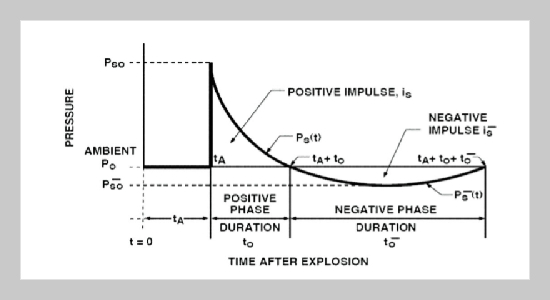REFERENCES
- [1] Department of the Army, Fundamental of Protective Design for Conventional Weapons, Technical Manual TM5-855-1, U.S.A., pp. 5.15.3 (1998).
- [2] Department of the Army, Structures to Resist the Effects of Accidental Explosions, TM5-1300, U.S.A., pp. 11867 (1990).
- [3] Cheng, D. S., Chiu, S. C. and Hung, C. W., “Validation of Fluid Structure Interaction Models of Reinforced Concrete Structures Subjected to Internal Explosion,” 3rd Int. Conf. Design and Analysis of Protective Structures, Singapore, May 10-12, pp. 155164 (2010).
- [4] Cheng, D. S., Chang, J. L., Chung C. N. and Hung, C. W., “Effect of Erosion Value of Strain on Crater Size of Reinforced Concrete Plates Subjected to Shaped Charge,” 3rd Int. Conf. Design and Analysis of Protective Structures, Singapore, May 10-12, pp. 194200 (2010).
- [5] Chen, H. C., Hung, C. W. and Yu, W. F., “Validation of Fluid Structure Interaction Models of Magazines Subjected to Internal Explosion,” 8th Int. Conf. Shock � Impact Loads on Structures, Adelaide, Australia, Dec 2-7, pp. 189197 (2009).
- [6] Lai, H. H., Chiu, S. C., Cheng, D. S. and Hung, C. W., “Effect of Steel, CFRP and GFRP-Retrofitted Plate on Crater of Reinforced Concrete Subjected to Contact Explosion,” 8th Int. Conf. Shock � Impact Loads on Structures, Adelaide, Australia, Dec 2-7, pp. 363370 (2009).
- [7] Hung, C. W., Yu, W. F. and Cheng, D. S., “A Parametric Study of Explosion Simulation for Reinforced Concrete Slab Subjected to a Rectangular Explosive,” International Symposium on Interaction of the Effects of Munitions with Structures 12.1, Orlando, U.S.A., Sept. 18-21 (2007).
- [8] Yu, W. f., Hung, C. W. and Cheng, D. S., “Effect of Subdividing Stacks on Blast Overpressure from Explosion Inside Ammunition Storage Magazine,” J. Explosives and Propellants, Vol. 24, No. 2, pp. 2540 (2008).
- [9] Yu, W. f., Hung, C. W. and Cheng, D. S., “Effect of Blast wall on Safety Distance of Ammunition Storage Magazine Subjected to Internal Explosion,” J. Chung Cheng Institute of Technology, Vol. 39, No. 2, pp. 131145, 2010.
- [10] Cheng, D. S. and Hung, C. W., “Experiment and Numerical Simulation of Peak Overpressure of C4 Explosives in the Airblast,” J. Explosives and Propellants, Vol. 26, No. 2, pp. 7596 (2010).
- [11] Pi, S. J., Cheng, D. S., Cheng, H. L., Li, W. C. and Hung, C. W., “Fluid-Structure-Interaction for a Steel Plate subjected to Non-Contact Explosion,” Theoretical and Applied Fracture Mechanics, Vol. 59, pp. 17 (2012).
- [12] Haufe, A., Weimar, K., and Göhner, U., “Advanced Airbag Simulation Using Fluid-Structure-Interaction And The Eulerian Method in LS-DYNA,” Proceedings of the third LS-DYNA forum, Bamberg, Germany, Oct. 14-15 (2004).
- [13] Gebbeken, N. and Ruppert, M., “On the Safety and Reliability of High Dynamic Hydrocode Simulations,” Int. J. for Numerical Methods in Engineering, Vol. 46, No. 6, pp. 839851 (1999).
- [14] Dobratz, B. M., Crawford, P. C., LLNL Explosives Handbook - Properties of Chemical Explosives and Explosives Simulates, Lawrence Livermore National Laboratory, UCRL-52997 Change 2, University of California, pp. 2223 (1985).
- [15] Mullin, J. M. and O’Toole, J. B., “Simulation of Energy Absorbing Materials in Blast Loaded Structures,” The 8th International LS-DYNA Users Conference, Michigan, U.S.A., May 2-4, pp. 6780 (2004).
- [16] LS-DYNA Version 971Rev 5 User’s Manual, Livermore Software Technology Corporation, U.S.A., pp. 12546 (2010).
- [17] Aquelet, N., “2D to 3D ALE mapping,” The 10th International LS-DYNA Users Conference, Michigan, U.S.A., Jun. 8-10, pp. 2334 (2008).
- [18] Lapoujade, V., Van Dorsselaer, N., Kevorkian, S. and Cheval, K., “A Study of Mapping Technique for Air Blast Modeling,” The 11th International LS-DYNA Users Conference, Michigan, U.S.A., Jun. 6-8, pp. 2331 (2010).









